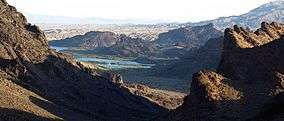Havasu National Wildlife Refuge
| Havasu National Wildlife Refuge | |
|---|---|
|
IUCN category IV (habitat/species management area) | |
 | |
 Map of the United States | |
| Location |
Mohave County, Arizona / San Bernardino County, California, USA |
| Nearest city | Needles, California |
| Coordinates | 34°36′34″N 114°25′02″W / 34.6095812°N 114.4173321°WCoordinates: 34°36′34″N 114°25′02″W / 34.6095812°N 114.4173321°W |
| Area | 37,515 acres (151.82 km2) |
| Established | 1941 |
| Governing body | U.S. Fish and Wildlife Service |
| Website | Havasu National Wildlife Refuge |
Havasu National Wildlife Refuge is a U.S. National Wildlife Refuge on the lower Colorado River in Arizona and California. It preserves habitat for desert bighorn sheep to the endangered southwestern willow flycatcher, birds and other animals. The refuge protects 30 river miles - 300 miles (480 km) of shoreline - from Needles, California, to Lake Havasu City, Arizona. One of the last remaining natural stretches of the lower Colorado River flows through the 20-mile-long (32 km) Topock Gorge.
Animal species that inhabit this refuge include peregrine falcon, coyote, fox, desert bighorn sheep, greater roadrunner, bobcat, and cougar. Thousands of bats emerge from historic mines and razorback suckers swim in the back of Beal Lake.
A large river in a dry, hot land attracts wildlife and people like a powerful magnet. Many thousands of visitors annually flock to the refuge to boat through the Topock Gorge, watch waterbirds in Topock Marsh, or hike to the Havasu Wilderness Area.
The Friends of the Bill Williams River and Havasu National Wildlife Refuges is a non-profit membership organization that supports and advocates for the Refuges. They assist Refuge Staff with several of the refuge annual events, strive to obtain grants to support refuge projects, conduct fund-raising activities to support environmental education programs, and help the Fish and Wildlife Service operate and maintain the refuge facilities and programs by providing volunteer labor.
References
![]() This article incorporates public domain material from websites or documents of the United States Fish and Wildlife Service.
This article incorporates public domain material from websites or documents of the United States Fish and Wildlife Service.
- Friends of the Bill Williams River and Havasu National Wildlife Refuges
- Bird Checklist for Havasu National Wildlife Refuge
- Sonoran Desert topics index